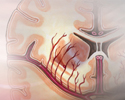Stroke risk factors
Preventing stroke; Stroke - prevention; CVA - prevention; TIA - prevention
A stroke occurs when blood flow to a part of the brain suddenly stops. A stroke is sometimes called a "brain attack or cerebrovascular accident." If blood flow is cut off for longer than a few seconds, the brain cannot get nutrients and oxygen. Brain cells can die, causing lasting damage.
Risk factors are things that increase your chance of getting a disease or condition. This article discusses the risk factors for stroke and things you can do to lessen your risk.
What is a Risk Factor?
A risk factor is something that increases your chance of getting a disease or health problem. Some risk factors for stroke you cannot change. Some you can. Changing the risk factors that you have control over will help you live a longer, healthier life.
Risk Factors you Cannot Change
You cannot change these stroke risk factors:
- Your age. The risk of stroke goes up with age.
- Your sex. Men have a higher risk of getting heart disease than women, except in older adults.
- Your genes and race. If your parents had a stroke, you are at higher risk. African Americans, Mexican Americans, American Indians, Hawaiians, and some Asian Americans also have a higher risk.
- Diseases such as cancer, chronic kidney disease, autoimmune diseases, and some types of arthritis.
- Weak areas in an artery wall or abnormal arteries and veins.
- Pregnancy. Both during and in the weeks right after the pregnancy.
Blood clots from the heart may travel to and block the blood vessels in the brain and cause a stroke. This may happen in people with manmade or infected heart valves. It may also happen because of a heart defect you were born with.
A very weak heart and abnormal heart rhythm, such as atrial fibrillation, can also cause blood clots.
Risk Factors you can Change
Some risk factors for stroke that you can change are:
- Not smoking. If you do smoke, quit. Ask your doctor for help quitting.
- Controlling your cholesterol through diet, exercise, and medicines, if needed.
- Controlling high blood pressure through diet, exercise, and medicines, if needed. Ask your doctor what your blood pressure should be.
- Controlling diabetes through diet, exercise, and medicines, if needed.
- Exercising at least 30 minutes every day.
- Maintaining a healthy weight. Eat healthy foods, eat less, and join a weight loss program, if you need to lose weight.
- Limiting how much alcohol you drink. Women should have no more than 1 drink a day, and men no more than 2 a day.
- Do not use cocaine and other recreational drugs.
Birth control pills (particularly the estrogen content) can raise your risk of blood clots. Clots are more likely in women who also smoke and who are older than 35. Talk with your doctor about other birth control options that do not increase the risk of blood clots.
Good nutrition is important to your heart health. It will help control some of your risk factors.
- Choose a diet rich in fruits, vegetables, and whole grains.
- Choose lean proteins, such as chicken, fish, beans and legumes.
- Choose low-fat dairy products, such as 1% milk and other low-fat items.
- Avoid sodium (salt) and fats found in fried foods, processed foods, and baked goods.
- Eat fewer animal products and fewer foods with cheese, cream, or eggs.
- Read food labels. Stay away from saturated fat and anything with partially-hydrogenated or hydrogenated fats. These are unhealthy fats.
Your doctor may suggest taking aspirin or another blood thinner to help prevent blood clots from forming. Do not take aspirin without talking to your doctor first. If you are taking these medicines, take steps to prevent yourself from falling or tripping, which can lead to bleeding.
Follow these guidelines and the advice of your doctor to lower your chances of stroke.
References
American Diabetes Association. Standards of medical care in diabetes – 2020. Diabetes Care. 2020 Jan;43(Suppl 1). diabetesjournals.org/care/article/43/Supplement_1/S77/30758/7-Diabetes-Technology-Standards-of-Medical-Care-in.
Biller J, Schneck MJ, Ruland S. Ischemic cerebrovascular disease. In: Jankovic J, Mazziotta JC, Pomeroy SL, Newman NJ, eds. Bradley and Daroff's Neurology in Clinical Practice. 8th ed. Philadelphia, PA: Elsevier; 2022:chap 65.
Campbell BCV, Khatri P. Stroke. Lancet. 2020;396(10244):129-142. PMID: 32653056 pubmed.ncbi.nlm.nih.gov/32653056/.
Review Date: 1/28/2021
Reviewed By: Evelyn O. Berman, MD, Assistant Professor of Neurology and Pediatrics at University of Rochester, Rochester, NY. Review provided by VeriMed Healthcare Network. Also reviewed by David Zieve, MD, MHA, Medical Director, Brenda Conaway, Editorial Director, and the A.D.A.M. Editorial team.


